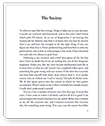Essay Instructions: Choose TWO of the following questions to answer. In each of your answers be sure to include: a discussion of at least 4 artists (at least 1 non-French) and at least 6 artworks (at least 3 of which must date before 1850, and 3 of which after 1850). Make sure you spell the artists' names correctly and have the correct titles and dates for the paintings. You may discuss the artworks in terms of form and/or content, depending on what is appropriate. Make sure you contextualize your discussion with specific references to social, political, and/or cultural conditions at the time the works were produced. You may conduct outside research for your answers, but do no need to use citations, unless you quote directly, in which case include the source of your quote (both the person and the book/page). Keep quotes very short as they detract from your discussion. Do not plagarize, because I have read most of the 19th century literature, and plagarizing will result in a grade of 0, regardless of how brilliant other are. Make sure your essays are fact-filled, well-organized, with all points thoroughly explained. You will be graded on content, coherence, persuasiveness, and writing (grammar, spelling, syntax).
Write 1 four page (ca. 1000 word) answer to 2 of the following questions: Make sure to specify the question you are choosing!
1) Artists as reformers. According to Leo Tolstoy and others, the true role of the artist is to educate and reform society through their art. Beginning with the 18th century, explain how artists accomplish this.
2) Nostalgia for the past. The late 18th and 19th century was an era of revivals. From the Neoclassical works of David to the medieval influence on the Synthetists, various styles of the past appealed to Europeans for a variety of reasons. Discuss the general reasons for this nostalgia and then specific instances of it, in terms of artists and movements.
3) Development of Modernism. Both in form and content, Modernism began to develop during the 19th century. Modernist content can be interpreted as representing one's own time or subject matter that comes from 'within' and modernist form can be interpreted as the awareness of the artificiality of the art making process and an interest in the independent expressive qualities of form and color, and as technical experimentation. Chosing EITHER form or content, trace the development of Modernism in 19th century art.
4) Search for Truth. Enlightenment ideals inspired philosophers, scientists, and artists to search for, reveal, and study the TRUTH. Select artists who represent different aspects of this search and explain how it is manifested in the works they produced, and why this search was important in the context of the historical moment.
5) Attitudes toward tradition. By 1800, art academies, with their reverence for the classical past, had dominated artist education for a century. Some artists embraced tradition, some wanted to update it while upholding its ideals,others rejected it. Chose at least one artist from each of these three categories and explain how their works exemplified these various goals, and explain the reasons for their preferences in the context of the time.
6) Urbanization and Industrialization. Europe transformed from an agrarian, rural to an industrial, urban society during the course of the 19th century. This radical social and economic shift had a tremendous impact on all aspects of cultural life. Explain the shifts that occurred and how they affected the subjects, forms, and styles of art produced during the century.
For all of your statements, make sure you explain why your statement is true or valid.


